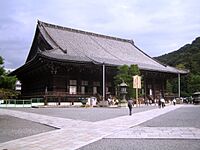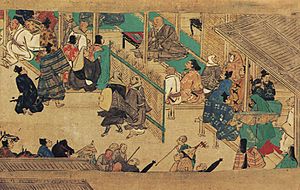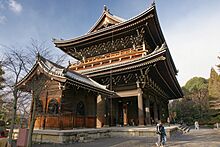Jōdo-shū facts for kids
Quick facts for kids Jōdo-shū |
|
|---|---|

Chion-in, Grand Head Temple of the Chinzei Branch of Jōdo-shū
|
|
| Classification | Pure Land Buddhism |
| Scripture | The Three Pure Land Sutras and the Senchakushū |
| Headquarters | Chion-in (Chinzei), Eikan-dō Zenrin-ji (Seizan) |
| Founder | Honen Shonin |
| Origin | 1175 Kyoto, Japan |
| Separated from | Tendai |
| Members | Over 6,000,000 |
| Ministers | 9,500 |
| Official website |
|
|
Basic terms |
|
|
People |
|
|
Schools |
|
|
Practices |
|
|
study Dharma |
|
Jōdo-shū (浄土宗, "The Pure Land School"), also known as Jōdo Buddhism, is a major branch of Pure Land Buddhism. It was started in Japan in 1175 by a monk named Hōnen. Jōdo-shū is one of the most widely practiced types of Buddhism in Japan today, along with Jōdo Shinshū. It is part of a larger group called Jōdo Buddhism, which also includes the Ji-shu and Yuzu Nembutsu shu schools.
Contents
History of Jōdo-shū Buddhism
Who Was Hōnen, the Founder?
Hōnen (法然) was born in 1133 in Mimasaka Province, Japan. His birth name was Seishimaru. When he was nine years old, his father was killed. Hōnen then began living as a monk. He studied at the famous Mount Hiei monastery.
Hōnen was known for his great knowledge. He also followed the Five Precepts, which are important rules for monks. However, he became unhappy with the teachings he learned at Mount Hiei. He was inspired by the writings of a Chinese monk named Shandao. Hōnen decided to focus only on Amitābha Buddha. He believed that repeating the phrase `nembutsu` was the best way to connect with Amitābha.
Over time, Hōnen gained many followers. People from all walks of life joined him. This included women, who had often been left out of serious Buddhist practice before. Some followers were very strict with Buddhist rules. Others believed Amitābha Buddha would save them no matter what. This led to some criticism from older Buddhist groups.
To address these concerns, Hōnen asked his followers to sign the Seven Article Pledge in 1204. This pledge asked them not to criticize other Buddhist groups. It also asked them to uphold the Buddha's teachings. Many of his main students signed this pledge.
Challenges and Exile
Even after the pledge, some older temples were still unhappy. In 1207, the Kofukuji temple complained to the Emperor. Around the same time, two of Hōnen's students, Jūren and Anraku-bō, taught some ladies who served Emperor Go-toba. These ladies then decided to become nuns. The Emperor became very angry.
Because of this, the Emperor ordered Hōnen and several followers to be exiled. This meant they had to leave their homes and go to faraway places. Jūren and Anraku-bō were executed.
A student of Shinran named Yuien-bō wrote about this event:
Master Honen and seven of his disciples were exiled, and four other disciples were executed. The Master was banished to a place called Hata in Tosa province and, stripped of ordination, given a secular name: the male Fujii no Motohiko; he was seventy-six years old. Shinran was exiled to Echigo province. His secular name was Fujii no Yoshizane, he was thirty-five. [Among the others exiled:] Jomon-bo, to Bingo province; Chosai Zenko-bo, to Hoki province; Kokaku-bo, to Izu province; Gyoku Hohon-bo, to Sado province. It was also determined that Kosai Jokaku-bo and Zenne-bo both receive banishment, but the former abbot of Mudo-ji temple took them under his custody.
Hōnen was eventually pardoned in 1211. He returned to Kyoto but died soon after in 1212. He gave his final message, the One-Sheet Document, to his student Genchi just two days before he passed away.
What Happened After Hōnen?
After Hōnen's death, his students in the capital gathered his writings. They also built a special tomb for him. However, his students Ryūkan, Chōsai, and Shōkú started to disagree on some teachings.
In 1227, Hōnen's main work, the Senchakushū, became widely known. This angered the monks at Enryakuji temple. They sent warriors to attack Hōnen's tomb. This event is known as the Karoku Persecution. Luckily, Hōnen's body and copies of his book were moved to safety. But other writings were destroyed, and more students were exiled.
How Jōdo-shū Branches Developed
Many of Hōnen's students were sent to faraway provinces. Each of them started a local community. They taught Hōnen's ideas, but sometimes with small differences. Today, only two main lines of these teachings remain: the Chinzei-ha branch and the Seizan-ha branch. Other groups, like Jodo Shinshu and the Ji-shū sects, became separate schools.
| Jodo-Shu Lineage Chart | |||||||||||||||||||||||||||||||||||||||||||||||||||||||||||||||||||||||||||||||||||||||||||||||||||||||||||||||||||||||||||||||||||||||||||||||||||||||||||||||||||||||||||||||||||||||||||||||||||||||||||||||||||||||||||||||||||||||||||||||||||||||||||||||||||||||||||||||||||||||||||||||||||||||||||||||||||||||||||||||||||||||||||||||||||||||||||||||||||||||||||||||||||||||||||||||||||||||||||||||||||||||||||||||||||||||||||||||||||||||||||||||||||||||||||||||||||||||||||||||||||||||||||||||||||||||||||||||||||||||||||||||||||||||||||||||||||||||||||||||||||||||||||||||||||||||||||||||||||||||||||||||||||||||||||||||||||||||||||||||||||||||||||||||||||||||||||||||||||||||||||||||||||||||||||||||||||||||||||||
|---|---|---|---|---|---|---|---|---|---|---|---|---|---|---|---|---|---|---|---|---|---|---|---|---|---|---|---|---|---|---|---|---|---|---|---|---|---|---|---|---|---|---|---|---|---|---|---|---|---|---|---|---|---|---|---|---|---|---|---|---|---|---|---|---|---|---|---|---|---|---|---|---|---|---|---|---|---|---|---|---|---|---|---|---|---|---|---|---|---|---|---|---|---|---|---|---|---|---|---|---|---|---|---|---|---|---|---|---|---|---|---|---|---|---|---|---|---|---|---|---|---|---|---|---|---|---|---|---|---|---|---|---|---|---|---|---|---|---|---|---|---|---|---|---|---|---|---|---|---|---|---|---|---|---|---|---|---|---|---|---|---|---|---|---|---|---|---|---|---|---|---|---|---|---|---|---|---|---|---|---|---|---|---|---|---|---|---|---|---|---|---|---|---|---|---|---|---|---|---|---|---|---|---|---|---|---|---|---|---|---|---|---|---|---|---|---|---|---|---|---|---|---|---|---|---|---|---|---|---|---|---|---|---|---|---|---|---|---|---|---|---|---|---|---|---|---|---|---|---|---|---|---|---|---|---|---|---|---|---|---|---|---|---|---|---|---|---|---|---|---|---|---|---|---|---|---|---|---|---|---|---|---|---|---|---|---|---|---|---|---|---|---|---|---|---|---|---|---|---|---|---|---|---|---|---|---|---|---|---|---|---|---|---|---|---|---|---|---|---|---|---|---|---|---|---|---|---|---|---|---|---|---|---|---|---|---|---|---|---|---|---|---|---|---|---|---|---|---|---|---|---|---|---|---|---|---|---|---|---|---|---|---|---|---|---|---|---|---|---|---|---|---|---|---|---|---|---|---|---|---|---|---|---|---|---|---|---|---|---|---|---|---|---|---|---|---|---|---|---|---|---|---|---|---|---|---|---|---|---|---|---|---|---|---|---|---|---|---|---|---|---|---|---|---|---|---|---|---|---|---|---|---|---|---|---|---|---|---|---|---|---|---|---|---|---|---|---|---|---|---|---|---|---|---|---|---|---|---|---|---|---|---|---|---|---|---|---|---|---|---|---|---|---|---|---|---|---|---|---|---|---|---|---|---|---|---|---|---|---|---|---|---|---|---|---|---|---|---|---|---|---|---|---|---|---|---|---|---|---|---|---|---|---|---|---|---|---|---|---|---|---|---|---|---|---|---|---|---|---|---|---|---|---|---|---|---|---|---|---|---|---|---|---|---|---|---|---|---|---|---|---|---|---|---|---|---|---|---|---|---|---|---|---|---|---|---|---|---|---|---|---|---|---|---|---|---|---|---|---|---|---|---|---|---|---|---|---|---|---|---|---|---|---|---|---|---|---|---|---|---|---|---|---|---|---|---|---|---|---|---|---|---|---|---|---|---|---|---|---|---|---|---|---|---|---|---|---|---|---|---|---|---|---|---|---|---|---|---|---|---|---|---|---|---|---|---|---|---|---|---|---|---|---|---|---|---|---|---|---|---|---|---|---|---|---|---|---|---|---|---|---|---|---|---|---|---|---|---|---|---|---|---|---|---|---|---|---|---|---|---|---|---|---|---|---|---|---|---|---|---|---|---|---|---|---|---|---|---|---|---|---|---|---|---|---|---|---|
|
|||||||||||||||||||||||||||||||||||||||||||||||||||||||||||||||||||||||||||||||||||||||||||||||||||||||||||||||||||||||||||||||||||||||||||||||||||||||||||||||||||||||||||||||||||||||||||||||||||||||||||||||||||||||||||||||||||||||||||||||||||||||||||||||||||||||||||||||||||||||||||||||||||||||||||||||||||||||||||||||||||||||||||||||||||||||||||||||||||||||||||||||||||||||||||||||||||||||||||||||||||||||||||||||||||||||||||||||||||||||||||||||||||||||||||||||||||||||||||||||||||||||||||||||||||||||||||||||||||||||||||||||||||||||||||||||||||||||||||||||||||||||||||||||||||||||||||||||||||||||||||||||||||||||||||||||||||||||||||||||||||||||||||||||||||||||||||||||||||||||||||||||||||||||||||||||||||||||||||||
The largest branch of Jōdo-shū is the Chinzei-ha (鎮西派, "The Chinzei Branch"). It started in the hometown of Hōnen's student, Benchō. The Seizan-ha (西山派, "The Seizan Branch") grew around the capital city of Kyoto. This was because Shōkū and Chōsai, two important students, were not exiled.
Shinran, another student of Hōnen, started his own communities. His teachings eventually became different enough to form a separate sect called Jodo Shinshu.
Other important students of Hōnen include:
- Genchi: He was Hōnen's personal helper in Kyoto. He later helped unite his lineage with the Chinzei branch. He also witnessed Hōnen's final message, the One-Sheet Document.
- Shinkū: He helped build Hōnen's tomb. He also protected Hōnen's important items during the 1227 persecution.
- Ryūkan: He was an older student of Hōnen. He believed that repeating the `nembutsu` very often was important. His teachings were called the "many callings school."
- Kōsai: He believed that saying the `nembutsu` just once was enough. This caused some arguments, and Hōnen eventually disagreed with his teachings.
- Chōsai: He was one of Hōnen's last direct students. He believed that other Buddhist practices could also help people reach the Pure Land.
- Kujō Kanezane: He was a powerful leader from the Fujiwara Clan. He helped protect Hōnen from political problems.
- Awanosuke: This fortune-teller is said to have created the special double-stranded Buddhist prayer beads used in Jōdo-shū.
Uniting the Branches
A generation later, Benchō's student, Ryōchū, helped spread Hōnen's teachings across Japan. Ryōchū helped make the "Chinzei branch" the main part of Jōdo-shū. He is seen as the third important leader after Hōnen. Ryōchū also met Renjaku-bo, whose teacher Genchi was another student of Hōnen. They agreed that their teachers had similar ideas. This helped unite their groups and made the Chinzei branch even stronger.
Jōdo-shū continued to grow through the Chinzei line. The 8th leader, Shōgei (1341-1420), made it an official, independent Buddhist school. He set up formal training for priests.
Jōdo-shū in Later Periods
In 1590, during the Azuchi–Momoyama period, Jōdo-shū received support from Tokugawa Ieyasu, a powerful leader. This brought a time of great success for the sect. Zōjō-ji temple in Edo (now Tokyo) became the family temple of the Tokugawa clan. Many Tokugawa leaders are buried there.

The Meiji Restoration in 1868 was a difficult time for Japanese Buddhism. The government tried to separate Shinto and Buddhism. This led to a movement called haibutsu kishaku. Temples were destroyed, and monks were forced to leave their roles.
Jōdo-shū had been supported by the government before. Now, it had to make changes. Several monks became important reformers. Tetsujō Ukai was a Buddhist historian and head priest of Chion-in. He defended Buddhism against attacks and highlighted its importance in Japanese culture.
Fukuda Gyōkai was another key figure. He was a scholar and head priest of Chion-in. He worked to keep Buddhist traditions alive. He also wanted to update social welfare based on Buddhist philosophy. He helped create a group that united different Buddhist sects. This group worked for modernization and to prevent too much Christian influence.
Before and during World War II, Jōdo-shū, like other Buddhist groups, faced pressure to support Imperial Japan. The Jōdo-shū organization followed the government's policy. They built temples in Japan's overseas colonies. They also held services for soldiers and helped their families. After the war, the school apologized for its actions during that time.
After World War II, some temples broke away from the main Chinzei Branch. But this separation did not last long. In 1961, most of these groups rejoined the main Chinzei branch. This branch is still the largest part of Jōdo-shū today.
Where Jōdo-shū Is Found

Most Jōdo-shū followers are in Japan. However, there are also many followers in Hawaii. You can also find some temples in the continental United States and Brazil. The first Jōdo-shū temple in Hawai'i was built in 1896. The first temple in mainland America was built in 1936 in Los Angeles, California.
What Jōdo-shū Believes
Pure Land Buddhist ideas had been around in Japan for a long time. But Hōnen's teaching was special. He taught `senju nembutsu`, which means "exclusive nembutsu." This means that the only real way to be reborn in the Pure Land is by repeating the `nembutsu`.
Hōnen believed that rebirth in the Pure Land happens because of Amida Buddha's kindness. The `nembutsu` is specifically mentioned in the Immeasurable Life Sutra. This sutra talks about Amida Buddha's 18th Vow, also known as the Primal Vow. Hōnen taught that in the later age of `Mappō`, people could no longer follow the Buddha's teachings perfectly. So, the `nembutsu` was the only practice that would truly work. Other practices would not add to or take away from Amida Buddha's power.
The Immeasurable Life Sutra says:
The Buddha further said, "I have expounded this teaching for the sake of sentient beings and enabled you to see Amitāyus and all in his land. Strive to do what you should. After I have passed into Nirvāṇa, do not allow doubt to arise. In the future, the Buddhist scriptures and teachings will perish."
But, out of pity and compassion, I will especially preserve this sutra and maintain it in the world for a hundred years more. Those beings who encounter it will attain deliverance in accord with their aspirations.
Jōdo-shū was founded when Buddhism in Japan was very involved in politics. Some monks were seen as rich and powerful. People felt that society had reached a difficult time. Based on the passage above, they believed other practices were no longer effective.
Hōnen wanted to give everyone a simple Buddhist practice. He wanted anyone to be able to reach enlightenment, no matter how difficult the times. He was worried that many people were left out of other Buddhist groups.
Hōnen said:
"The reason I founded the Jōdo [浄土, Pure Land] sect was that I might show the ordinary man how to be born into the Buddha’s real land of recompense [e.g. the Pure Land]. According to the Tendai sect, the ordinary man may be born into the so-called Pure Land, but that land is conceived of as a very inferior place. Although the Hossō [Yogacara] sect conceives of it as indeed a very fine superior place, they do not allow that the common man can be born there at all. And all the sects, though differing in many points, all agree in not allowing that the common man can be born into the Buddha’s land of real compensation....Unless I start a separate sect, the truth that the common man may be born into the Buddha’s land of compensation will be obscured, and it will be hard to realize the deep meaning Amida [Buddha]’s Original Vow [to provide a refuge for all beings]."
Hōnen believed that salvation came mostly from Amida Buddha's power. So, anyone who sincerely repeated the `nembutsu` could be reborn in the Pure Land.
How Jōdo-shū Is Practiced
The most important practice in Jōdo-shū is repeating the `nembutsu`. This phrase is namu amida butsu (南無阿弥陀仏, "Praise to the Buddha Amitabha"). It comes from the Primal Vow of Amitābha Buddha. People can say the `nembutsu` in different ways at home or in temples:
- Jūnen: This means "Ten Recitations." You say the `nembutsu` ten times.
- Nembutsu Ichie: This means "Nembutsu Gathering." You say the `nembutsu` as many times as you can during a sitting.
- Nembutsu Sanshōrai: This means "Three Intonations of Praise." This involves saying the `nembutsu` in a long, drawn-out way three times, followed by a bow. This is repeated two more times.
Besides the `nembutsu`, followers are encouraged to do other "auxiliary" practices. These include following the five precepts, meditating, chanting sutras, and doing good deeds. There are no strict rules for these extra practices. Jōdo-shū teaches that Amitābha's kindness reaches everyone who says the `nembutsu`. So, how a person does these other practices is up to them. Jōdo-shū followers can also worship kami (spirits) and visit Shinto shrines. They just should not worship kami as a way to enter the Pure Land.
The main Buddhist scripture for Jōdo-shū is the Sutra of Immeasurable Life. This sutra is the basis for the belief in the Primal Vow of Amida Buddha. The Amitāyurdhyāna Sūtra and the Amitabha Sutra are also important. Together, these three are called the Sanbukyō (三部経, "Three Pure Land Sutras").
Hōnen's own writings are also very important. Most of them are in the Senchaku-hongan-nembutsu-shū (or Senchakushū). His last writing, the Ichimai-Kishōmon (一枚起請文, "One-Sheet Document"), is also key. Much of what we know about Hōnen comes from these writings and letters to his students. The One-Sheet Document is read aloud every day in Jōdo-shū services.
Jōdo-shū Temples and Leaders
Jōdo-shū has professional priests, just like other Buddhist schools. It has two main temples. One is Chion-in in Kyoto, and the other is Zojoji in Tokyo. The main leader of the Jōdo-shū school is called the monshu. This leader lives at the Chion-in temple. The Seizan branch has three smaller branches, each with its own main temple.



